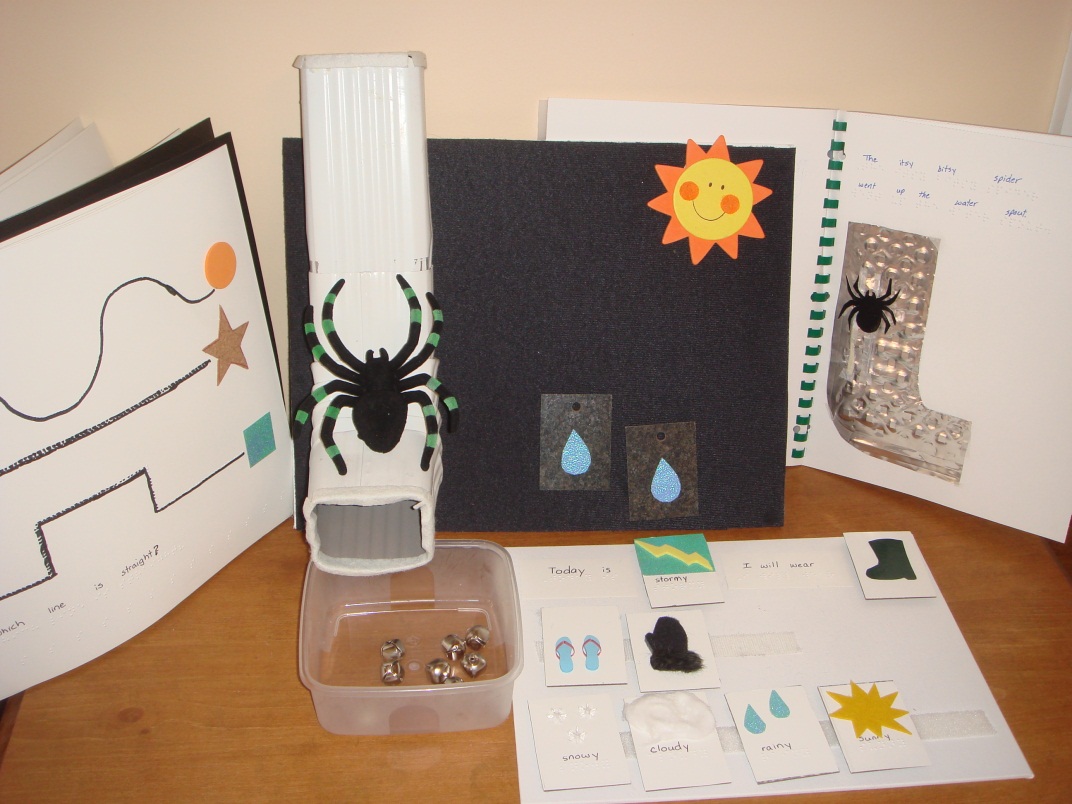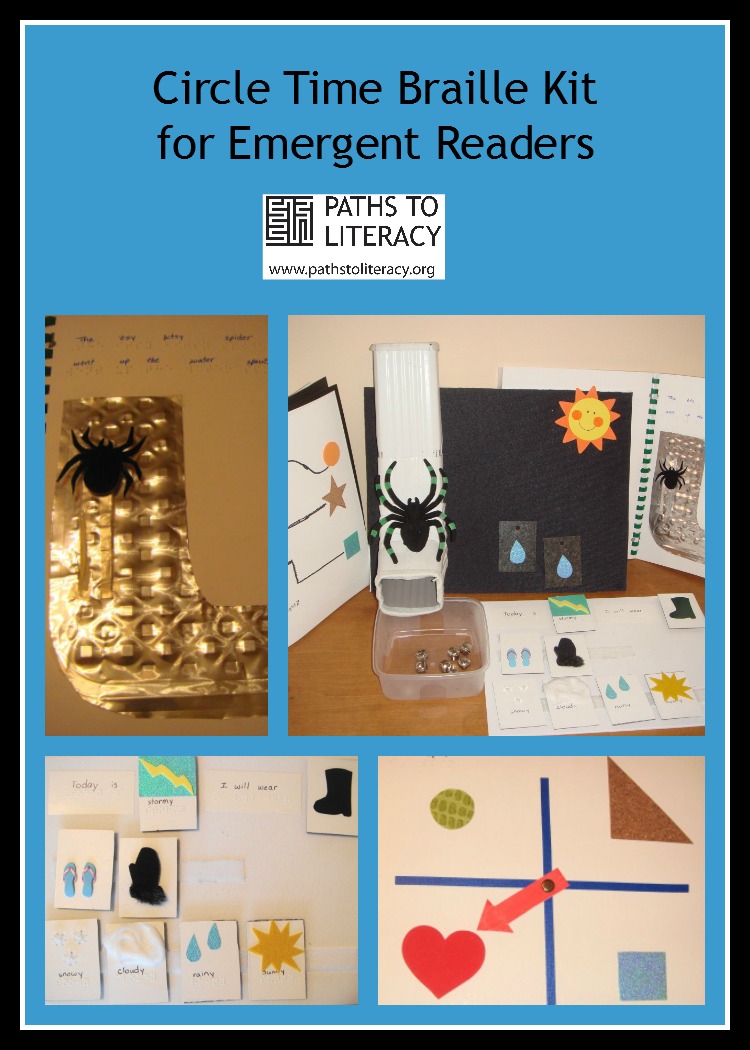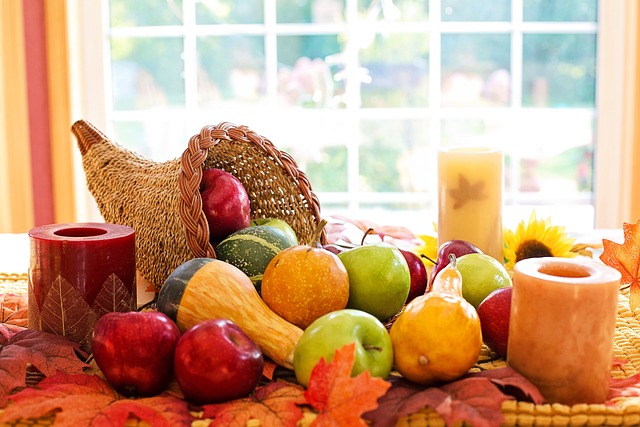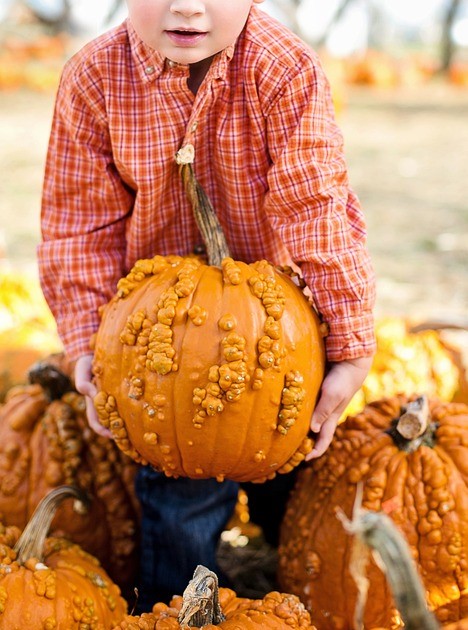Theme: Itsy Bitsy Spider is a Circle Time Braille Kit that focuses on the letter “s”, spiders, weather and counting to 8.
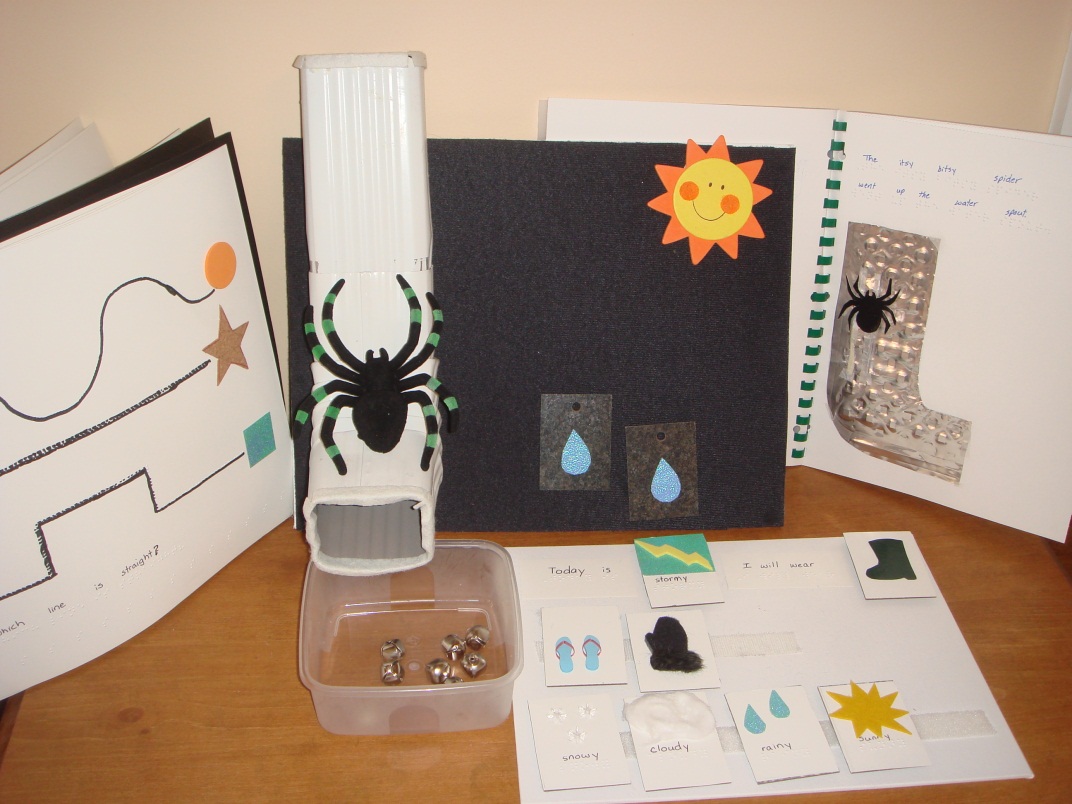
This kit is designed to be used together with the Letter “S” Interactive Braille Book, which is found a separate page.
Warning: There are small pieces in this kit that may not be appropriate for all students. Students should be closely supervised when using items in this kit. Please be sure to teach (and monitor) gentle handling of the objects and tactile materials to ensure safety and to increase the kit’s usable lifespan.
This Circle Time PRE-BRAILLE Kit Contains:
Tactile Books:
- print/ braille/tactile book
Objects:
- Real Objects: (spider model, down spout, bells and container to catch bells)
- Story Board (Bigger board with spider, down spout, bells, container, wooden sun, rain drops)
- Weather board (smaller board with weather and clothing symbols)
- Interactive Alphabet Book: “S”
Auditory Story/Song:
- Recommend iPad/iTouch/iPhone app “Itsy Bitsy Spider” by Duck Duck Moose
Computer Games: Itsy Bitsy and Itsy Bitsy Spider
Related Documents:
- Itsy Bitsy Spider Book Directions
- Itsy Bitsy Spider Song in Spanish (Itzi, bitzi araña)
- Spanish sentences for related activities
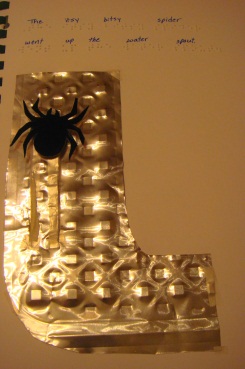
Teacher Hints –BEFORE the student reads the story:
-
Transcribers Note: Grade I (uncontracted) braille is used in this kit. In the book, gently slide the spider up and down the water spout.
-
Define and describe a spider using the three-dimensional spider as a model. (Explain that the model is much bigger than a real spider!) Spider Fun Facts: A spider has two parts to his body. He has eight legs and eight eyes. Spiders like to climb things and often build their webs up high. The webs trap insects for the spiders to eat. Spiders smell with their legs. See Spider Fun Facts at the end of this Teacher Guide for more information.
-
Define and describe a water spout (gutter) while encouraging the student to explore the real water spout. Definition: A water spout (gutter) is a plastic or metal channel/tube that goes from the roof to the ground. Water runs off the roof through the water spout to the ground.
-
The original song was probably intended to explain that many spiderlings (baby spiders) climb tall things (like the water spout) and then “balloon” away from the spout by using their own silk to ride the wind, sometimes for thousands of feet. This helps them move away from their brothers and sisters to avoid fighting for food.
Activities:
Story Board
Story boards are sturdy boards covered in “headliner” material that enables the wooden story characters or objects (with Velcro) to stick to the board. Students can interact with the story board as the story is being read or the student can re-enact the story using the story board. Other activities, such as counting, sequencing the story events, etc. can also be done with the story board.
- Students can re-enact the story using the spider and downspout. The bells can be dropped into the down spout to indicate rain drops. (The sound of the bells in the downspout sounds similar to rain in a downspout.) Place the container under the water spout to catch the bells. Students can count the bells (8) as they drop them down the water spout and also count the spider’s legs (8). Students can place the rain drops and or wooden sun (attached with Velcro) on the board as he repeats the story.
- What happens if it snows? If the wind blows?* Make up your own poem or use this one:
The itsy bitsy spider climbed up the water spout.
Down came the snow and froze the spider out.
Out came the sun and melted all the snow
And the itsy bitsy spider had another go.
The itsy bitsy spider climbed up the water spout.
The wind blew in the clouds then blew the spider out.
Out came the sun and away went the wind
And the itsy bitsy spider climbed up the spout again.
*Use the weather symbols (snow and clouds) to re-enact the new poem on the story board.
- The itsy bitsy spider story can also be used to teach about persistence and hard work. If the little spider had given up on the first try, then she would have never made it to the top of the water spout!
- Use the story board to teach “in” and “out” by placing the bells “in/out” of the water spout and “in/out” of the container.
Who Did What? Comprehension game
Teacher chooses which “W” questions to ask: Who did What? Where? When? and Why?
After reading the story, ask the student Who? (Who was in the story? – Spider) Did What? (What happened in the story? – Spider climbed up and down) When? (When did the spider go up? – When it was sunny. When did the spider go down? – When it rained) and Where? (Where was the spider? – On the water spout) and Why? (Why did the spider climb up the water spout? inferred – to make her web).
Hand Motions
Students love to do the common hand motions with this poem. (Students with visual impairments will need to be shown how to do these motions):
For the first and last lines, touch the thumb of one hand to the index finger of the other. Twist the hands (one hand faces out while the other hand faces in) then place the opposite thumb to the opposite index finger. Alternate touching the thumb and index fingers while moving both hands higher up in the air (to show the spider is climbing up). “Down came the rain. . .” Starting with hands above your head, spread fingers wide, palms down, and wiggle all finger while lowering the hands. “Washed the spider out. . .” Brush the hands forcibly to the right side. “Out came the sun. . . ” Fingertips touching (palms down) above your head. Your arms will form a big circle. For the additional verses add motions for the snow (light, gentle snow finger movements to represent snowflakes) and clouds/wind (blowing air or wavy motions with hands).
Interactive Alphabet Book
See the Letter “S” Interactive Braille Book on a separate page.
Concepts in the “S” interactive book
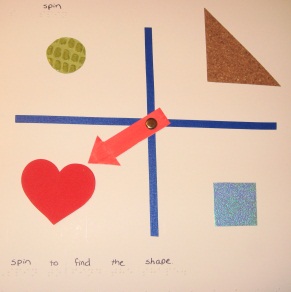
- Slide: Slide the spider up and down.
- Squeeze: Squeeze the toy to make it squeak.
- Same: Which triangles have the same textures?
- Smooth: Which side is smooth? Right or left?
- Small: Which star is small? Which square is not small?
- Straight: Which line is straight?
- Spin: Spin to find the shape.
- Spiders: Count the spiders. How many legs does a spider have?*
- S: Which cards have the letter S? **
Weather Board: (weather board, weather symbols, clothing symbols)
Preschool and kindergarten classrooms incorporate weather concepts into daily circle time activities. The weather activity in this kit uses tactile symbols (with Velcro) that the student can move in order to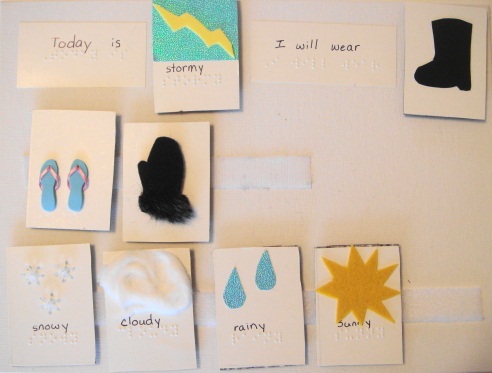 complete the sentence, “Today is ______.” Ask the student to choose the most appropriate weather symbol- sunny, rainy, cloudy, snowy, or stormy. The student can place the correct symbol to complete the braille sentence. “I will wear _____.” This weather activity can be expanded to include choosing appropriate things to wear in different types of weather – flip flops for sunny, mittens for snowy, rubber boots for rainy. These concepts can be verbally expanded to include: When do you wear shorts? Long pants? Jackets? Etc.
complete the sentence, “Today is ______.” Ask the student to choose the most appropriate weather symbol- sunny, rainy, cloudy, snowy, or stormy. The student can place the correct symbol to complete the braille sentence. “I will wear _____.” This weather activity can be expanded to include choosing appropriate things to wear in different types of weather – flip flops for sunny, mittens for snowy, rubber boots for rainy. These concepts can be verbally expanded to include: When do you wear shorts? Long pants? Jackets? Etc.
*Additional Activities: Classroom center can include dress up clothes for pretend play – rain boots, child safe umbrella, rain coat, winter coat, winter boots, mittens, scarf, long sleeve shirt, short sleeve shirt, swim suit, wind jacket, etc. When doing the weather each day, have a student pick the correct clothing and wear it as he pretends to be the “weather man” and tells what the weather is that day.
Directions for making the weather board are included in the attached documents (Itsy Bitsy Spider Book directions).
Rain Dance – class activity
Students will work together to create the sound of a rain storm in the classroom. Students should sit in a semi-circle, divided into three parts. The first section will rub their hands together to make the sound of “mist”. The teacher will then prompt the second section to join in by rubbing their hands together. Then the third section will join in by rubbing their hands together. (Now all three sections are rubbing their hands together.) Next, the teacher will prompt the first section to snap their fingers (rain drops). (Snapping fingers can be skipped if students are unable to snap their fingers.) Have the second section join in by snapping their fingers, then the third section. Next, have the first section pat their legs (downpour), then add the second section and later the third section. For the peak of the thunderstorm (thunder), students will stomp their feet, adding each section separately. As the thunderstorm subsides, students will make all the sounds in reverse order (pat legs, snap fingers, rub hands).
Raindrop Counting
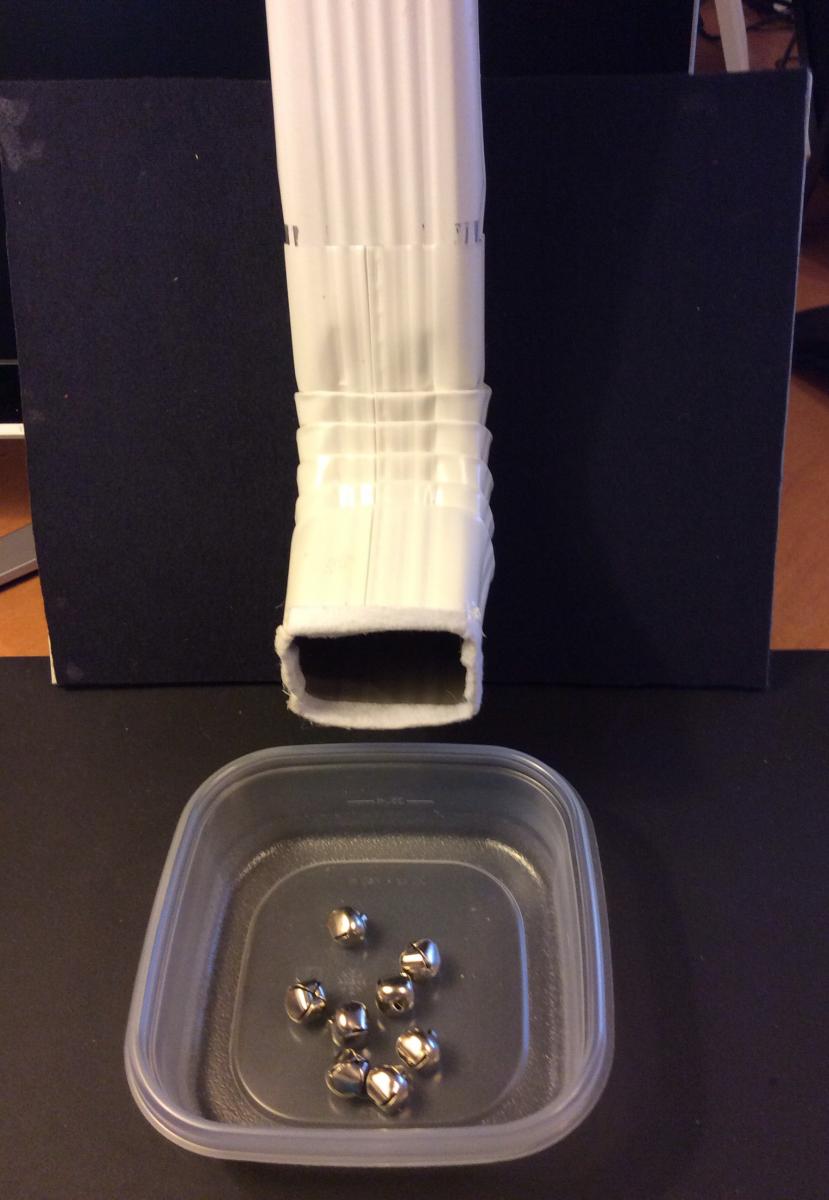
(bells; if class activity, clear flat floral marbles on blue felt/construction paper is suggested but not included in this kit)
The teacher will clap her hands a certain number of times (making “thunderclaps”). The student will count out the corresponding amount of raindrops.
Puddle Jumping
(carpet squares – not included in the kit)
Spread carpet squares and have the student jump over or jump in/out of the pretend “puddles”.
Fun Facts
Fun Facts are additional information to foster concept develop about objects that were in the story. If appropriate for your student, use the following Fun Facts when exploring/learning about spiders.
- Spiders have two body parts
- Most spiders have 8 eyes (some have 6 eyes)
- Spiders have 8 legs
- Spiders like to climb
- All spiders make silk
- Spiders spin webs out of the silk
- They spin their webs at night
- Spiders eat insects
- Spiders catch insects in their sticky webs
- Spiders do not stick to their webs because their legs are covered in oil
- Spiders turn their food into soup and suck it up
- Spiders have blue blood
- Baby spiders are called spiderlings
- Some spiders carry their babies on their back
- Spiders smell with their legs
Computer Games
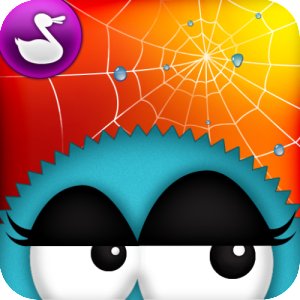
- Paid iPad game called “Itsy Bitsy Spider” by Duck Duck Moose.
Journal prompt
Spiders like to climb. What do you like to climb? What is your favorite kind of weather? What do you like to do then?
Poems/Songs
What’s for Lunch?
A spider invited
A fly for lunch
Crunch
Crunch
Crunch.
Spider Webs
by Amy Goldman Koss
The spider weaves a sticky web
To capture bugs to eat.
What keeps the spider’s sticky web
From sticking to her feet?
Spider webs are very tricky
Because not all the strands
are sticky.
Unlike the passing hapless fly,
The spider knows which strands
are dry.
But if she accidentally stands
Upon one of the sticky strands,
She still would not get stuck,
you see —
Her oily body slides off free.
Spider, Spider
Spider, spider
Spin you web
Catching insects
In your thread
How many insects
Can you catch?
One, two, three. . .
The Spider in the Web
(tune: Farmer in the Dell)
The spider in the web,
The spider in the web
Spin, spin, oh watch him spin,
The spider in the web.
The spider eats a (bug name)
The spider eats a _________.
Spin, spin, oh watch him spin,
The spider in the web.
See also The Five Little Monkeys Circle Time Braille Kit.

